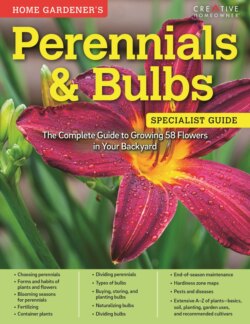Читать книгу Home Gardener's Perennials & Bulbs - Miranda Smith - Страница 8
PLANNING
ОглавлениеA perennial is a plant that lives for at least three years. The plants we think of as perennials are, for the most part, herbaceous, meaning that aboveground parts of the plant—the stems and leaves—are soft and green, not woody. In cold climates the top growth of most herbaceous perennials dies back each winter and the plants become dormant; in spring, new top growth develops. In warm climates, some perennials are evergreen, retaining their leaves and stems all year; others become dormant during summer droughts.
USING PERENNIALS
Perennials are flower garden classics. You can grow them in beds and borders by themselves, in combination with annuals and bulbs, or with small shrubs, trees, and ground covers.
The majority of perennials are most valued for their lovely flowers, though many produce attractive foliage. The art of garden design is partially a matter of combining plants with various blossom colors, textures, and shapes. With perennials—as opposed to annuals that bloom all season—time also becomes an important design element. Because most perennials bloom for just a few weeks a season, you’ll need to choose plants that bloom at differing times to have garden color throughout the season.
Many perennials spend most of the growing season as a clump of stems and leaves, so good design also depends on choosing plants for their overall form, texture, and foliage. In fact, experienced garden designers treat plant form, texture, and foliage as the primary design qualities, and flower color as a secondary consideration. See here for examples of some of the most common plant and flower forms and here for foliage qualities.
CHOOSING PLANTS
As you begin to choose perennials, make a list of plants that you’ve seen and liked in other gardens, books, and nursery catalogs. For each one, note the flower color and form, its time of bloom, the height and shape of the plant, and its foliage shape and color. This may sound like a lot of work, but it makes things much easier when you lay out your garden. To help narrow down your list, weed out all the plants that aren’t suited to your growing conditions—temperatures, light, soil, and moisture.
If making this list seems daunting, rest assured that many a good garden has come into being through a process of trial and error. Don’t be intimidated. After all, if you don’t like a perennial in one spot, you can always dig it up and move it next year.
Add interest to your garden by combining plants with a variety of sizes, forms, and flower types, as well as a pleasing mix of colors.
Add interest to your garden by combining plants with a variety of sizes, forms, and flower types, as well as a pleasing mix of colors.
PLANT FORMS AND HABITATS
Plants grow in a number of forms, or growth habits. Combining plants with a variety of growth habits adds interest to any planting. Choose from the following when planning your beds and borders:
Mounded—rounded and bushy, mounded plants form a cushion of foliage, usually close to the ground. Examples include bergenia (left) and lady’s mantle (Alchemilla, right)
Branching—branching plants grow upright, with branched stems that give them an open appearance. Examples include false spirea (Astilbe species, left) and asters (right).
Upright—some plants are decidedly vertical with a narrow, upright form. Blazing star (Liatris spicata, left) and irises (right) are common upright plants.
Trailing or matlike—some plants stay low to the ground because they sprawl. Perennials that fit this category include these garden pinks (Dianthus species, top), and creeping phlox (Phlox subulata, bottom).
